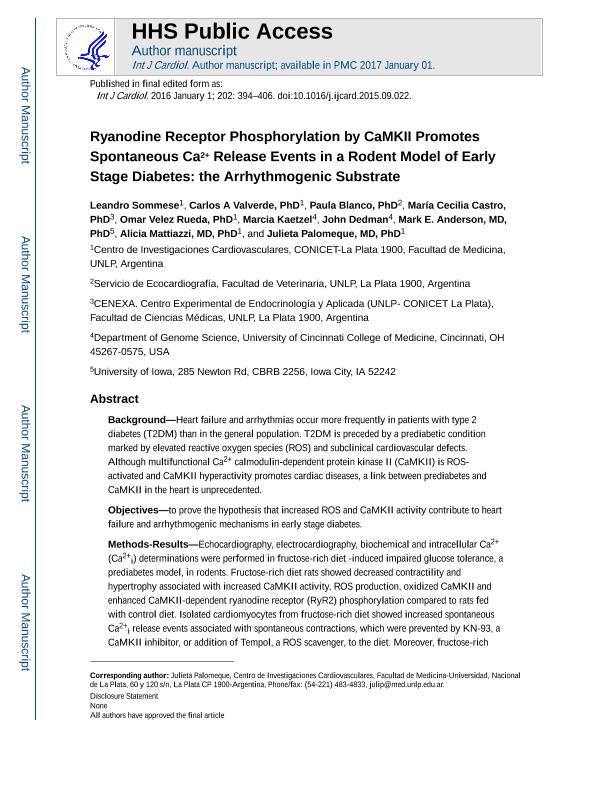Artículo
Ryanodine receptor phosphorylation by CaMKII promotes spontaneous Ca2+ release events in a rodent model of early stage diabetes: The arrhythmogenic substrate
Sommese, Leandro Matías ; Valverde, Carlos Alfredo
; Valverde, Carlos Alfredo ; Blanco, Paula Graciela
; Blanco, Paula Graciela ; Castro, María Cecilia
; Castro, María Cecilia ; Velez Rueda, Jorge Omar
; Velez Rueda, Jorge Omar ; Kaetzel, Marcia; Dedman, John; Anderson, Mark E.; Mattiazzi, Ramona Alicia
; Kaetzel, Marcia; Dedman, John; Anderson, Mark E.; Mattiazzi, Ramona Alicia ; Palomeque, Julieta
; Palomeque, Julieta
 ; Valverde, Carlos Alfredo
; Valverde, Carlos Alfredo ; Blanco, Paula Graciela
; Blanco, Paula Graciela ; Castro, María Cecilia
; Castro, María Cecilia ; Velez Rueda, Jorge Omar
; Velez Rueda, Jorge Omar ; Kaetzel, Marcia; Dedman, John; Anderson, Mark E.; Mattiazzi, Ramona Alicia
; Kaetzel, Marcia; Dedman, John; Anderson, Mark E.; Mattiazzi, Ramona Alicia ; Palomeque, Julieta
; Palomeque, Julieta
Fecha de publicación:
01/2016
Editorial:
Elsevier Ireland
Revista:
International Journal Of Cardiology
ISSN:
0167-5273
Idioma:
Inglés
Tipo de recurso:
Artículo publicado
Clasificación temática:
Resumen
Background: Heart failure and arrhythmias occur more frequently in patients with type 2 diabetes (T2DM) than in the general population. T2DM is preceded by a prediabetic condition marked by elevated reactive oxygen species (ROS) and subclinical cardiovascular defects. Although multifunctional Ca2+ calmodulin-dependent protein kinase II (CaMKII) is ROS-activated and CaMKII hyperactivity promotes cardiac diseases, a link between prediabetes and CaMKII in the heart is unprecedented.
Objectives: To prove the hypothesis that increased ROS and CaMKII activity contribute to heart failure and arrhythmogenic mechanisms in early stage diabetes.
Methods–Results: Echocardiography, electrocardiography, biochemical and intracellular Ca2+ (Ca2+i) determinations were performed in fructose-rich diet-induced impaired glucose tolerance, a prediabetes model, in rodents. Fructose-rich diet rats showed decreased contractility and hypertrophy associated with increased CaMKII activity, ROS production, oxidized CaMKII and enhanced CaMKII-dependent ryanodine receptor (RyR2) phosphorylation compared to rats fed with control diet. Isolated cardiomyocytes from fructose-rich diet showed increased spontaneous Ca2+i release events associated with spontaneous contractions, which were prevented by KN-93, a CaMKII inhibitor, or addition of Tempol, a ROS scavenger, to the diet. Moreover, fructose-rich diet myocytes showed increased diastolic Ca2+ during the burst of spontaneous Ca2+i release events. Mice treated with Tempol or with sarcoplasmic reticulum-targeted CaMKII-inhibition by transgenic expression of the CaMKII inhibitory peptide AIP, were protected from fructose-rich diet-induced spontaneous Ca2+i release events, spontaneous contractions and arrhythmogenesis in vivo, despite ROS increases.
Conclusions: RyR2 phosphorylation by ROS-activated CaMKII, contributes to impaired glucose tolerance-induced arrhythmogenic mechanisms, suggesting that CaMKII inhibition could prevent prediabetic cardiovascular complications and/or evolution.
Palabras clave:
Arrhythmias
,
Prediabetes
,
Impaired Glucose Tolerance
,
Camkii
,
Ryanodine Receptor
Archivos asociados
Licencia
Identificadores
Colecciones
Articulos(CCT - LA PLATA)
Articulos de CTRO.CIENTIFICO TECNOL.CONICET - LA PLATA
Articulos de CTRO.CIENTIFICO TECNOL.CONICET - LA PLATA
Articulos(CENEXA)
Articulos de CENTRO DE ENDOCRINOLOGIA EXP.Y APLICADA (I)
Articulos de CENTRO DE ENDOCRINOLOGIA EXP.Y APLICADA (I)
Articulos(CIC)
Articulos de CENTRO DE INVEST.CARDIOVASCULARES (I)
Articulos de CENTRO DE INVEST.CARDIOVASCULARES (I)
Citación
Sommese, Leandro Matías; Valverde, Carlos Alfredo; Blanco, Paula Graciela; Castro, María Cecilia; Velez Rueda, Jorge Omar; et al.; Ryanodine receptor phosphorylation by CaMKII promotes spontaneous Ca2+ release events in a rodent model of early stage diabetes: The arrhythmogenic substrate; Elsevier Ireland; International Journal Of Cardiology; 202; 1-2016; 394-406
Compartir
Altmétricas



